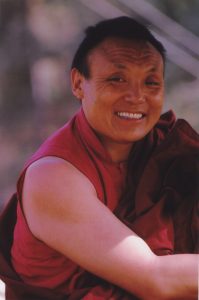
Upon the death of the 7th Khamtrul, it was foretold that he would be reborn into the family of his mother as her grandson. The 8th Khamtrul Rinpoche was born on the 9th day of the 1st Tibetan month in 1931 to Trinley kunchab and Ngoedrub Lhatso in Nangchen, East Tibet in modern day Qinghai, China. Trinley Kunchab was the brother of the 7th Khamtrul Rinpoche.
A few months after his birth, an old master and some monks from Khampagar Monastery visited the family. The child instantly recognized Ven. Yerab, the old master. Because of this and other auspicious signs, the Regent of the 13th Dalai Lama issued a written declaration affirming the authenticity of the 7th Khamtrul Rinpoche’s rebirth. The lamas and monks of Khampagar Monastery unanimously resolved to enthrone the infant child as the 8th Khamtrul Rinpocge. Yonge Tulku, acting Regent of the monastery, Ven. Lama Hara Palior, tutor of the 7th Khamtrul Rinpoche, and eight other senior monks travelled to the home of the 8th Khamtrul Rinpoche to request that the son of Trinley and Ngoedrub be enthroned as the 8th Khamtrul Rinpoche at Khampagar Monastery. Upon seeing Ven. Hara Paljor for the first time, the four years old child showed signs of intimate recognition, as he would to his own parents. Many wonderful signs manifested during the ceremonies leading up to his enthronement. At his Upasaka robe offering ceremony, it began to rain and a rainbow appeared. Several days later, the child went out to play with twenty wild sheep that had surrounded his tent and though he pulled their ears and horns, they remained calm and unafraid of him. When he was enthroned, large snowflakes appeared in the forms of various flowers.
The 8th Khamtrul Rinpoche received an excellent monastic education under the guidance of various great masters. Among them, the 8th Choegon Rinpoche Choekyi Gyamtso, root guru of the 7th Khamtrul Rinpoche, gave him complete Drukpa Kagyu lineage teaching and initiations. He also learned Tibetan poetry, composition, astrology, history, logic, dialectics and philosophy from Khenpo Dondam. He passed all the exams for qualification as a Vajra Acharya of the twelve mandala practices of Khampagar Monastery. With his expertise in painting, metal work, architecture, wood carving and tailoring, Rinpoche was also a very accomplished artist.
Tireless in keeping his Bodhisattva vows to save all sentient beings, Rinpoche travelled extensively throughout Tibet, granting teachings and performing sadhanas, as well as spending long periods in retreat. In Khampagar Monastery, Rinpoche transmitted the whole series of Drukpa Kagyu teachings to Dorzong Rinpoche, Sephu Gyalwang and many other heads of Drukpa Kagyu monasteries.
At the age of 28th, when the Chinese began to openly destroy Tibet, its culture and people, Rinpoche left for India. After spending some time in Kalimpong, Banuri and Dalhousie, Rinpoche established the current monastic and lay communities of Tashi Jong in the Kangra Valley of Himachal Pradesh in 1968. As when in Tibet, Rinpoche journeyed widely to bestow teachings and empowerments to people in need. He travelled throughout Europe as well as in Sikkim, Bhutan and Nepal. After a stay in Bhutan for two years, he passed away on the 5th of January, 1980 at the age of 49.
 Khampagar Druk College Welcome…
Khampagar Druk College Welcome…

